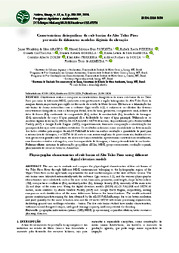Características fisiográficas de sub-bacias do Alto Teles Pires por meio de diferentes modelos digitais de elevação.
Características fisiográficas de sub-bacias do Alto Teles Pires por meio de diferentes modelos digitais de elevação.
Author(s): ARAÚJO, J. W. da S.; PAULISTA, R. S. D.; PEREIRA, R. R.; CASTAGNA, D.; BORELLA, D. R.; BARBOSA, K. L. da S.; ZOLIN, C. A.; FERREIRA, E. A.; SOUZA, A. P. de; ALMEIDA, F. T. de
Summary: Resumo: Objetivou-se avaliar e comparar as características fisiográficas de cinco sub-bacias do rio Teles Pires por meio de diferentes MDE, ambientes estes pertencente a região hidrográfica do Alto Teles Pires da margem direita, importante para região médio-norte do estado de Mato Grosso. Efetuou-se a delimitação das sub-bacias de forma automática com o software Qgis versão 3.22, e realizou-se os cálculos das diversas características fisiográficas, como a hierarquia fluvial, área da bacia, perímetro, comprimento axial, índices de fator de forma (Kf), coeficiente de compacidade (Kc), índice de circularidade (Ic), densidade de drenagem (Dd), sinuosidade do curso d`água principal (S) e declividade do curso d`água principal. Utilizando-se os modelos digitais de elevação (MDE) ALOS PALSAR e SRTM 30 metros, disponibilizado pelo Alaska Satellite Facility (ASF) e Google Earth Engine (GEE), respectivamente, buscando comparação e identificação das principais diferenças entre os índices estudados. Os resultados indicaram maior sensibilidade na determinação dos dados obtidos pela imagem do ALOS PALSAR devido sua melhor resolução e quantidade de pixel para a mesma área de drenagem, e o SRTM de 30 metros com menor exigência de processamento, facilitando em usos gerais e em grandes sub-bacias. As cinco sub-bacias estudadas apresentaram características semelhantes, com formatos estreitos e alongados, com boa capacidade de drenagem, e baixa potencialidade de enchentes. | Abstract: The aim was to evaluate and compare the physiological characteristics of five sub-basins of the Teles Pires River through different MDE, environments belonging to the hydrographic region of the Upper Teles Pires on the right bank, important for the mid-northern region of the state of Mato Grosso. The sub-basins were delimited automatically with the software Qgis version 3.22, and the various physiographic characteristics were calculated, such as the river orbit, basin area, perimeter, axial length, shape factor indices ( Kf), compactness coefficient (Kc), circularity index (Ic), drainage density (Dd), sinuosity of the main river (S) and slope of the main river. Using the digital elevation models (DEM) ALOS PALSAR and SRTM 30 meters, made available by Alaska Satellite Facility (ASF) and Google Earth Engine, respectively, seeking comparison and identification of the main differences between the trained indices. The results indicated greater sensitivity in determining the data obtained by the ALOS PALSAR image due to its better resolution and pixel quantity for the same deviation area and the 30-meter SRTM with lower processing requirements, facilitating general uses and large subscales. - basins. The five sub-basins studied have similar characteristics, with narrow and elongated shapes, with good drainage capacity, and low potential for flooding.
Publication year: 2024
Types of publication: Journal article
Observation
Some of Embrapa's publications are published as ePub files. To read them, use or download one of the following free software options to your computer or mobile device. Android: Google Play Books; IOS: iBooks; Windows and Linux: Calibre.
Access other publications
Access the Agricultural Research Database (BDPA) to consult Embrapa's full library collection and records.
Visit Embrapa Bookstore to purchase books and other publications sold by Embrapa.

